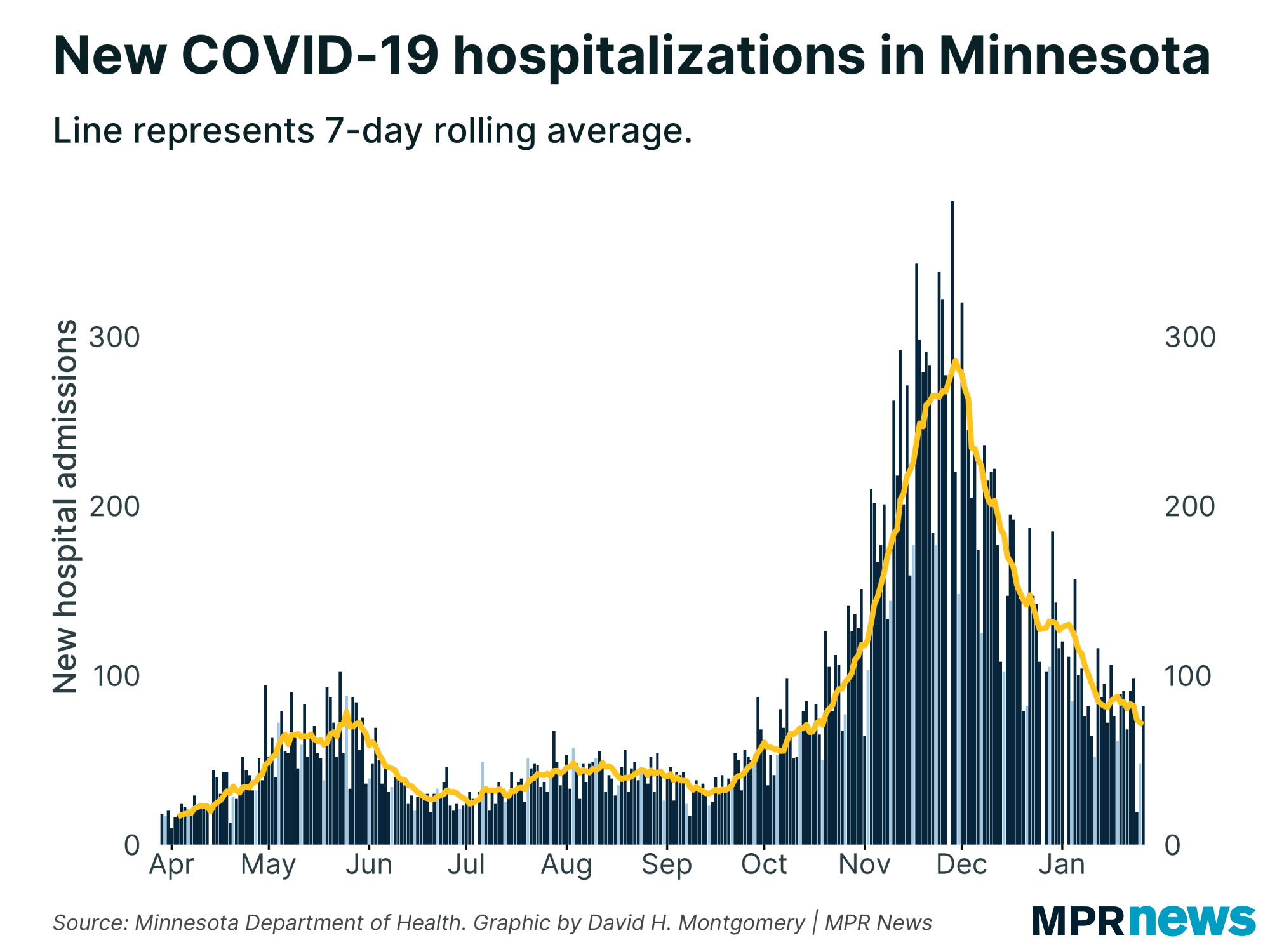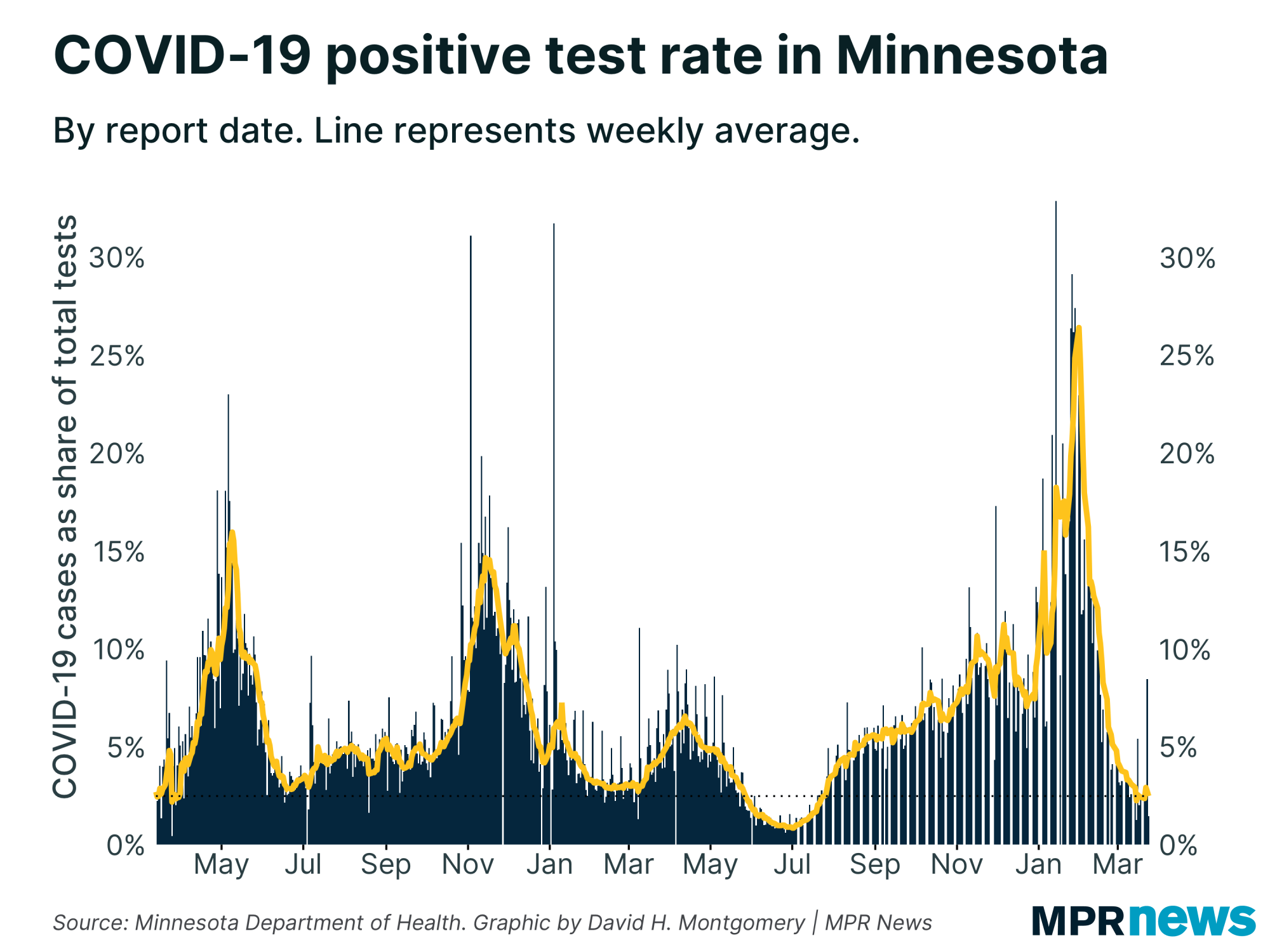Dec. 28 update on COVID-19 in MN: 13 deaths; new caseloads easing

Go Deeper.
Create an account or log in to save stories.
Like this?
Thanks for liking this story! We have added it to a list of your favorite stories.
Updated 12 p.m.
Minnesota officials on Monday reported another 13 COVID-19 deaths, continuing an already difficult December. Other closely watched metrics, however, are offering signs of hope.
New daily caseloads continue to retreat from their late November, early December peaks. The number of active, confirmed cases in Minnesota is below 14,000 for the first time since late October.

The Health Department posted 1,087 newly confirmed or probable COVID-19 cases, part of a two-week trend of relatively moderate new caseloads.
Hospitalization trends have also improved significantly the past two weeks. As of Sunday, 878 people were in the hospital with COVID-19 in Minnesota, with 203 needing intensive care.
Turn Up Your Support
MPR News helps you turn down the noise and build shared understanding. Turn up your support for this public resource and keep trusted journalism accessible to all.

The rate of tests coming back positive for COVID-19 — a figure officials use to judge the level of virus spread in the state — continues to ebb. The seven-day positive rate trend is at about 5.2 percent, down about two-thirds from its mid-November peak. A rate of 5 percent or more is considered concerning.

State health officials have warned that the improving picture could change dramatically if people don’t stay vigilant. They continue to implore people to wear masks in indoor gathering spaces, socially distance and take other measures to help stem the spread of COVID-19.
The cases reported Monday put Minnesota at 410,138 in the pandemic. Of those, about 93 percent have recovered to the point they no longer need to be isolated.

The newly reported deaths raised Minnesota’s toll to 5,160. Among those who’ve died, about 65 percent had been living in long-term care or assisted living facilities; most had underlying health problems.

Caseloads spread across age groups
People in their 20s still make up the age bracket with the state’s largest number of confirmed cases — more than 78,000 since the pandemic began, including more than 41,000 among people ages 20 to 24.

The number of high school-age youth confirmed with the disease has also grown, with nearly 32,000 total cases among those ages 15 to 19 since the pandemic began.
Although less likely to feel the worst effects of the disease and end up hospitalized, experts worry youth and young adults will spread it to grandparents and other vulnerable populations.
It’s especially concerning because people can have the coronavirus and spread COVID-19 when they don’t have symptoms.
New cases ebb across Minnesota
Central and western Minnesota drove much of the increase in new cases over the past two months, while Hennepin and Ramsey counties showed some of the slowest case growth in the state.
Cases continue to fall statewide, but still haven’t dipped down to their levels before the state’s COVID-19 surge that hit in November and early December. After a spike in confirmed cases through much of November and early December, all regions of the state have seen new case numbers fall.

Hot spots continue to pop up in rural counties relative to their population.

Caseloads still heaviest among people of color
In Minnesota and across the country, COVID-19 has hit communities of color disproportionately hard in both cases and deaths. That’s been especially true for Minnesotans of Hispanic descent for much of the pandemic.

Even as new case counts ease from their peak a few weeks ago, the data shows people of color continue to be hit hardest.
Distrust of the government, together with deeply rooted health and economic disparities, have hampered efforts to boost testing among communities of color, officials say, especially among unauthorized immigrants who fear their personal information may be used to deport them.
Similar trends have been seen among Minnesota’s Indigenous residents. Counts among Indigenous people jumped in October relative to population.
Developments around the state
State wants masks on youth hockey, hoops players
State health officials released new guidance on Monday for youth winter sports. Schools may begin games and scrimmages with other teams starting Jan. 14. Practices can start next Monday and may not include more than 25 people.
Student athletes must wear masks at all practices and games, even during high-exertion sports such as hockey and basketball. There are exceptions for swimmers while they're in the water, as well as wrestlers, and certain gymnastics and cheerleading routines.
In November, with COVID-19 cases on the rise, Gov. Tim Walz issued an executive order halting school sports. That drew the ire of a parents group, which filed a federal lawsuit.
— Matt Sepic | MPR News
Federal help on the way for jobless Minnesotans
A new federal pandemic relief package signed by President Donald Trump on Sunday will help thousands of unemployed Minnesotans.
Minnesota’s Commissioner of Employment and Economic Development Steve Grove said more than 300,000 Minnesotans are receiving unemployment.
“Over 100,000 Minnesotans risked falling out of the system, given the fact that these federal programs were ending so it was really important to have that new federal program signed into being last night and, of course, really important a few weeks back for Minnesotans to come together and do something at the state level, too,” the commissioner said.
The state has distributed a record amount of unemployment benefits this year amid the pandemic, Grove said.
"We've paid out over $9 billion to Minnesota and since the year began a lot of that, of course, straight federal money, but really a stunning about 10 times more than we've ever paid in a single year has gone out through our system and this past year due to the pandemic,” he said.
Grove says a state emergency program will cover a one-week gap in extra pandemic benefits for many unemployed Minnesotans before the the new federal aid begins flowing.
— Dan Gunderson | MPR News
Minnesota to get portion of $10B federal fund to help day care providers
Included in the COVID-19 relief bill President Donald Trump signed on Sunday are billions of dollars to help day care providers. $10 billion will be distributed to states based on a formula linked to poverty rates.
Chad Dunkley, president of the Minnesota Childcare Association, said the money Minnesota gets will likely be distributed in the form of emergency child care grants to providers, as was done under the earlier Cares Act.
He said the help is desperately needed for the child care industry that was struggling even before coronavirus hit. Keeping providers in business will be important to the nation's economic recovery, Dunkley said, and Minnesota has done more than any other state to help child care providers.
"The industry itself is facing really difficult times. We're seeing far fewer children at much higher costs per child to serve them to keep them safe. We hope this is a down payment and we hope states get this money and use is quickly,” he said.
Money from the previous aid package ran out this month, Dunkley said.
— Mark Zdechlik | MPR News
Top headlines
Trump reluctantly signs COVID aid, sparks fresh fight in GOP: Dropping his objections, President Donald Trump has signed a $2 trillion-plus COVID-19 and annual federal spending package into law. But Congress returns Monday to confront the White House on remaining priorities in a rare end-of-session showdown.
In the ICU and at George Floyd Square, one nurse fights two pandemics: Nurse Jeanette Rupert is hard to keep up with. When she's not treating COVID-19 patients in the ICU, she's dispensing medical care at George Floyd Square, just blocks from where she was born and raised. In the turbulence of 2020, Rupert says she's deepened her appreciation and commitment to her friends, family and community.
Emergency relief fund created for MN backstage professionals: The new Theater Emergency Relief Fund aims to help individuals who work in theater or dance production or design by offering grants of $1,200.
Your very good news in a really bad year: Most people will probably agree that it's been a terrible, horrible, no good, very bad year. But this is not a story about all the ills of the year. This is a story about the good that came out of 2020: love, births, new relationships, milestones and so much more.
COVID-19 in Minnesota
Data in these graphs are based on the Minnesota Department of Health's cumulative totals released at 11 a.m. daily. You can find more detailed statistics on COVID-19 at the Health Department website.


